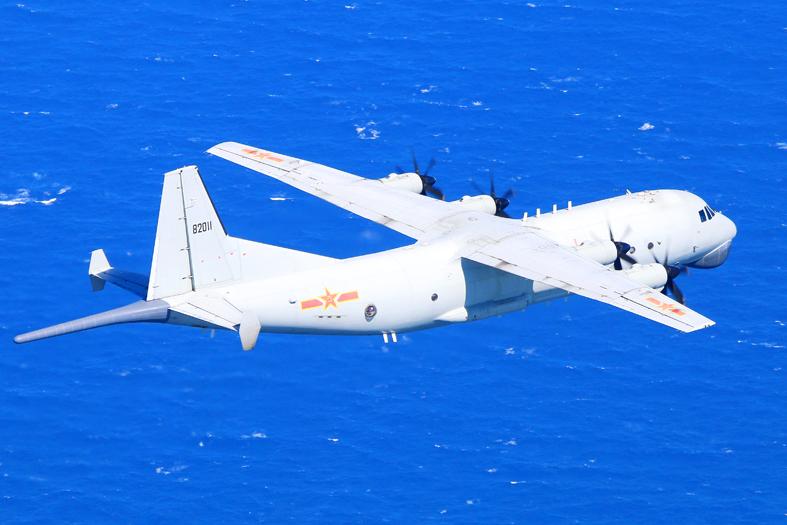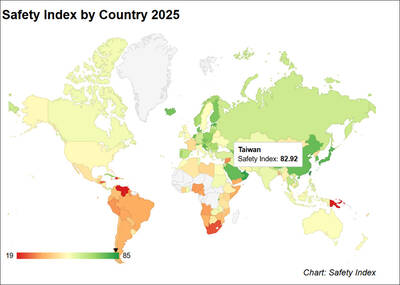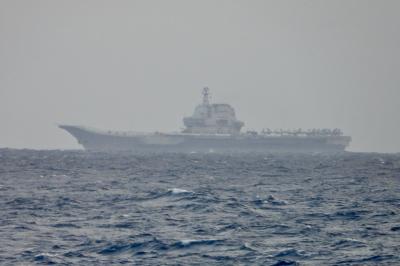The military tracked Chinese warplanes and responded as they encroached on Taiwan’s air defense identification zone (ADIZ) twice in the past four days, the Ministry of National Defense said yesterday.
Chinese fighter jets and bombers encroached on the nation’s ADIZ on Saturday last week and again on Monday, the ministry said.
On Monday, 10 aircraft — four J-16 multirole fighters, four J-10 multirole fighters, a KJ-500 airborne early warning and control aircraft and a Y-8 marine patrol aircraft — simultaneously approached Taiwan’s southwestern ADIZ from opposite directions before turning back, it said.

Photo courtesy of the Ministry of National Defense
The Japanese Ministry of Defense said that it also identified two Y-9 aircraft — one configured for reconnaissance and the other for electronic warfare — to Taiwan’s east.
Ministry spokesman Major General Shih Shun-wen (史順文) at a news conference said that the military successfully monitored the aircraft, and responded appropriately and effectively.
The military’s reaction to Chinese encroachment is determined by regulations on strategic and operational readiness, he said.
As a general principle, the military overestimates enemy capabilities, and generates a response that can anticipate and potentially block multiple, simultaneous hostile moves, Shih said.
The military avoids the “attrition trap” by varying its incursion responses by using a “high-low mix” of jets, slower aircraft, air-defense missile systems and electronic warfare, Air Force Chief of Staff Lieutenant General Huang Chih-wei (黃志偉) said.
Regarding the Japanese defense ministry’s statement, Huang said that each nation has its own criteria for disclosing defense information, but added that all threats to Taiwan were successfully monitored that day.
Association of Strategic Foresight research fellow Chieh Chung (揭仲) said that the incursions were Beijing’s way of showing its displeasure with the US, not immediate military threats.
Recent activity has been consistent with Beijing’s pattern of conducting a high-profile show of force when there is a development in US-China or Taiwan-US ties that it does not like, he said.
The Chinese aircraft were reportedly flying toward one another, but not conducting highly threatening maneuvers when circling Taiwan from opposite directions, he said, citing publicly available information.
On May 11, 2018, three formations of Chinese aircraft and ships circled Taiwan in the north, east and south, with the nearest observed aircraft only 56km from the naval base in Yilan County’s Suao Township (蘇澳), he said.
Two of the formations flew toward each other to encircle Taiwan’s eastern ADIZ, between the Bashi Channel and the Miyako Strait.
Two H-6K bombers, one Y-8 electronic warfare aircraft and one Tu-154 electronic warfare aircraft comprised the northbound group, while two H-6K bombers comprised the southbound one, he said.
The aircraft flew around Taiwan’s eastern airspace seven times from mid-April to late May 2018, Chieh said.
The military activity was a response to then-premier William Lai (賴清德) — now vice president — publicly describing himself as “a political worker for Taiwanese independence,” he said.
This story has been modified since it was first published.

AIR SUPPORT: The Ministry of National Defense thanked the US for the delivery, adding that it was an indicator of the White House’s commitment to the Taiwan Relations Act Deputy Minister of National Defense Po Horng-huei (柏鴻輝) and Representative to the US Alexander Yui on Friday attended a delivery ceremony for the first of Taiwan’s long-awaited 66 F-16C/D Block 70 jets at a Lockheed Martin Corp factory in Greenville, South Carolina. “We are so proud to be the global home of the F-16 and to support Taiwan’s air defense capabilities,” US Representative William Timmons wrote on X, alongside a photograph of Taiwanese and US officials at the event. The F-16C/D Block 70 jets Taiwan ordered have the same capabilities as aircraft that had been upgraded to F-16Vs. The batch of Lockheed Martin

GRIDLOCK: The National Fire Agency’s Special Search and Rescue team is on standby to travel to the countries to help out with the rescue effort A powerful earthquake rocked Myanmar and neighboring Thailand yesterday, killing at least three people in Bangkok and burying dozens when a high-rise building under construction collapsed. Footage shared on social media from Myanmar’s second-largest city showed widespread destruction, raising fears that many were trapped under the rubble or killed. The magnitude 7.7 earthquake, with an epicenter near Mandalay in Myanmar, struck at midday and was followed by a strong magnitude 6.4 aftershock. The extent of death, injury and destruction — especially in Myanmar, which is embroiled in a civil war and where information is tightly controlled at the best of times —

Taiwan was ranked the fourth-safest country in the world with a score of 82.9, trailing only Andorra, the United Arab Emirates and Qatar in Numbeo’s Safety Index by Country report. Taiwan’s score improved by 0.1 points compared with last year’s mid-year report, which had Taiwan fourth with a score of 82.8. However, both scores were lower than in last year’s first review, when Taiwan scored 83.3, and are a long way from when Taiwan was named the second-safest country in the world in 2021, scoring 84.8. Taiwan ranked higher than Singapore in ninth with a score of 77.4 and Japan in 10th with

China's military today said it began joint army, navy and rocket force exercises around Taiwan to "serve as a stern warning and powerful deterrent against Taiwanese independence," calling President William Lai (賴清德) a "parasite." The exercises come after Lai called Beijing a "foreign hostile force" last month. More than 10 Chinese military ships approached close to Taiwan's 24 nautical mile (44.4km) contiguous zone this morning and Taiwan sent its own warships to respond, two senior Taiwanese officials said. Taiwan has not yet detected any live fire by the Chinese military so far, one of the officials said. The drills took place after US Secretary